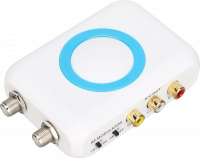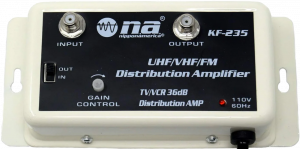CRT:Broadcasting Locally
Jump to navigation
Jump to search
| Disclaimer: Broadcasting without a license is illegal in most countries. Generally, so long as you are broadcasting with low power, signals will not be strong enough to leave your immediate area. Check your local laws and regulations before attempting anything described on this page. |
Since analog television is offline in almost all countries, channels are now unoccupied and can be used for a short range broadcast. This might be useful for running your own household TV station or to test televisions wirelessly.
Supplies
Broadcasting in your home requires three pieces:
- An RF signal source. This could be a device that outputs RF such as a NES or the output of a HDMI/composite-to-RF adapter.
- An RF amplifier. This is a simple device that takes the RF signal via coax input, amplifies it, and sends it to a coax output.
- A TV antenna. This can be a set of rabbit ears or any other TV antenna. In this case, we will use it to transmit rather than receive.
Setup
- Plug in power to all devices.
- Plug your RF source into the input of the RF amplifier.
- Plug your antenna into the output of the RF amplifier.
- Tune your TV to the channel that the RF source provides (usually channel 3 or 4).



